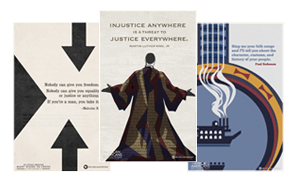Life After Emancipation ~ Lesson Activities
Lesson Activities
INTRODUCTORY ACTIVITY
- Begin by asking students to define “proclamation.” If no one volunteers or if students do not know, tell them that according to Merriam-Webster’s dictionary, a “proclamation” is “the act of saying something in a public, official, or definite way: the act of proclaiming something.” It is also defined as “an official statement or announcement made by a person in power or by a government.”
- Ask students what they think of when they hear the word “proclamation.” (Students will likely respond with the Emancipation Proclamation. If they do not, suggest this answer yourself.)
- Tell students that today you will be discussing the Emancipation Proclamation. You will be looking at what it means, as well as whether or not it has lived up to its promises.
- Distribute copies of the Emancipation Proclamation Transcript.
- Have students take turns reading the Proclamation aloud until you reach the end. Make sure students circle any words or phrases they don’t know or understand, and help clarify for them what these words/phrases mean.
- Next, read the Proclamation aloud yourself and have students follow along, underlining key words or phrases they think outline promises made.
- When you have reached the end, ask students to share some of the words and phrases they discovered. Answers may include:
- …all persons held as slaves within any State or designated part of a State the people whereof shall then be in rebellion against the United States shall be then, thenceforward, and forever free
- …the executive government of the United States…will recognize and maintain the freedom of such persons and will do no act or acts to repress such persons, or any of them, in any efforts they may make for their actual freedom.
- I do order and declare that all persons held as slaves within said designated States and parts of States are, and henceforward shall be, free; and that the Executive Government of the United States, including the military and naval authorities thereof, will recognize and maintain the freedom of said persons.
- I hereby enjoin upon the people so declared to be free to abstain from all violence, unless in necessary self-defence; and I recommend to them that, in all case when allowed, they labor faithfully for reasonable wages.
- …such persons of suitable condition will be received into the armed service of the United States
- Lead a discussion around some of the key phrases in the Emancipation Proclamation. Ensure students understand that the Proclamation aimed to free all slaves; said the government would not repress slaves seeking freedom; President Lincoln discouraged violence unless in self-defense and ordered that newly freed people earn “reasonable” wages; and that freed slaves would be allowed to enlist in the military.
- Ask students to read through the Emancipation Proclamation silently one final time. During this reading, students should pay close attention to key words or phrases that develop the tone of the Proclamation.
- Once students have finished reading, ask them to share what they found. (Accept all answers.) Ask: What is the tone conveyed in the Proclamation? (Accept all answers but suggest: strength, power, eminence.)
- Transition to the next activity by asking students what they think life was like for African Americans in the South after the Emancipation Proclamation. (Answers will vary, but students will likely know that it wasn’t until the Civil Rights movement that African Americans were truly “free” as outlined in the Emancipation Proclamation).
LEARNING ACTIVITY
- Tell students that they will be watching selected video segments from the PBS series The African Americans: Many Rivers to Cross to learn more about what life was like for African Americans after the Emancipation Proclamation. Tell students that, as they watch each video segment, they should consider whether the Emancipation Proclamation lived up to its name.
- Ask students if they know what “Jim Crow” laws were. (Jim Crow wasn’t a person, but instead referred to the laws and oppression faced by African Americans after the Emancipation Proclamation.)
- Focus the viewing of the first video segment by asking students to note some of the ways African Americans were oppressed. Play “Life After the Emancipation Proclamation.” Pause after author Isabel Wilkerson says “it had an overlay over every single thing they could do or imagine themselves being.”
- Ask students: What were some of the ways African Americans were oppressed? (There were separate bibles for white people and black people to take their oaths in court; it was illegal for white people and black people to play checkers together).
- If it is not discussed, reinforce the point made by Wilkerson: that while these laws were bad enough as they were, perhaps more importantly the laws “had an overlay over every single thing they could do or imagine themselves being.” Ask students what she meant by this. (Accept all answers, but students should understand that the laws themselves were unfair, but they had larger implications for African Americans in terms of viewing themselves as equals.)
- Resume playing “Life After the Emancipation Proclamation.” Provide a focus for the rest of this segment by asking students to note what the larger implications of Jim Crow laws were and how these “rules” were reinforced. (Note: the rest of this segment contains graphic images of lynchings.)
- Ask students: What were the larger implications of Jim Crow laws? (Jim Crow laws essentially relegated African Americans to second-class citizens, ensuring they believed and were treated as if they weren’t as good as white people. It meant that while African Americans were “free,” they didn’t truly have freedom.) Follow up by asking students how white people enforced Jim Crow laws. (Jim Crow was enforced through fear – lynchings were prevalent).
- Ask students to describe what lynchings were and how they were treated. (They were treated almost as entertainment – people traveled from miles away and even brought picnics.)
- Provide a focus question for the next segment by asking students to think about what the Emancipation Proclamation was supposed to mean and whether or not it fulfilled its promises.
- Play the video segment “The Great Migration.”
- After the segment has finished playing, ask students: Based on what you saw in the video segment, did the Emancipation Proclamation live up to its name? Why or why not? (Accept all answers, but suggest that the southern economy was dependent on African Americans to do the jobs that no one else wanted and for much cheaper. Though they were no longer technically enslaved, the dynamics between former slaveholders and their former slaves was still more or less the same, as was the financial exploitation.)
- Provide a focus for the next segment by asking students what a caricature is. Ask students if they have ever seen a caricature – what are they usually like? (Answers will vary, but should note that while some caricatures are good-natured, for the most part they emphasize stereotypical or negative parts of people and can be very offensive and used in cruel ways.) Tell students that during the next video segment, they will see extremely offensive caricatures and images; they should note how these images make them feel and also why, according to the video segment, these caricatures were developed.
- Play the video segment “The Subjugation of African Americans.”
- Ask students: How did the images make them feel? According to the video segment, what are some of the main reasons white people embarked on the propaganda campaign against African Americans? (The caricatures and negative images reinforced the African American as the “second-class citizen.” They also legitimized violence against African Americans and helped reinforce Jim Crow.)
- Provide a focus for the next video segment by asking students to identify one of the reasons white people took violent action against African Americans.
- Play the video segment “Resenting Prosperity and Equality.”
- After the video has finished playing, ask students: What is one of the reasons white people took violent action against African Americans? (According to the video segment, violence often broke out when white people resented the prosperous African American middle class. This reinforces the idea that white people still felt like African Americans were second-class citizens, and made sure African Americans were treated accordingly.)
- Revisit the question asked at the beginning of the lesson: Based on what students learned from the video segments, do they think the Emancipation Proclamation lived up to its name? Students should support their conclusions with evidence from the segments. (Answers will vary, but will likely conclude that while the Proclamation freed slaves, African Americans were not truly free. They did not have the same rights as white people; their interactions with former slaveholders were largely unchanged; white people took violent action against them, and many times it was because of resentment.)
CULMINATING ACTIVITY
- Tell students that you will now be looking at courageous individuals who stood up for the rights of African Americans and who fought for equality.
- Provide a focus for the final video segment by asking students to note some of the actions taken to fight for equality and how these actions made a difference.
- Play the video segment “The Realities of Separate but Equal.”
- Revisit the focus question: What were the actions taken by Charles Hamilton Houston and Victor Hugo Green? How did each man’s actions make a difference? (Houston fought for educational equality. He made a documentary comparing white schools and African American schools – emphasizing “separate and unequal.” Houston began building a legal case against Jim Crow. His actions ultimately led to the groundbreaking Brown v. Board of Education Supreme Court case. Victor H. Green created The Negro Motorist Green Book, which listed safe places for African Americans to get service, including hotels, restaurants, etc. The book also represented insurance against indignities African Americans faced every day. In a larger sense, the book also helped liberate African Americans – they could more easily travel and leave the South because of the book.)
- Tell students that there were many other African Americans who fought for equality during the Jim Crow era. Either as an in-class assignment or for homework, students will research and write a short (1-2 page) essay about one of these individuals. Distribute the Historical Figure Assignment.
- Collect the students’ essays to evaluate the assignment.
Find educational resources related to this program - and access to thousands of curriculum-targeted digital resources for the classroom at PBS LearningMedia.
Visit PBS Learning Media






